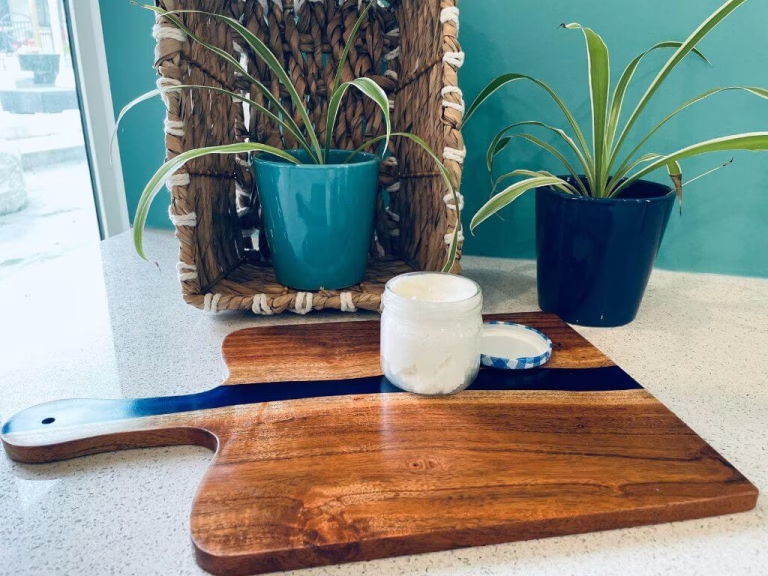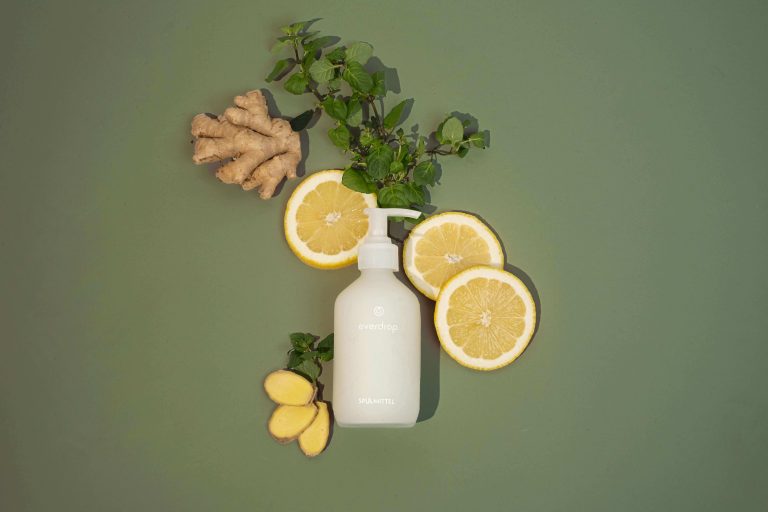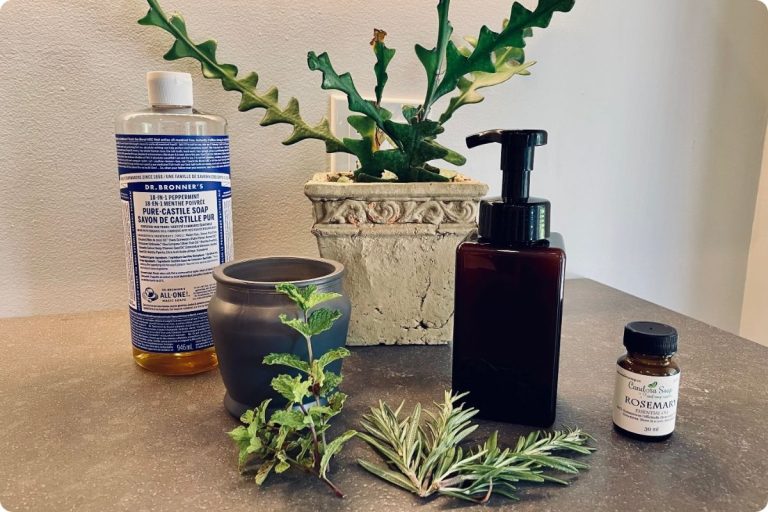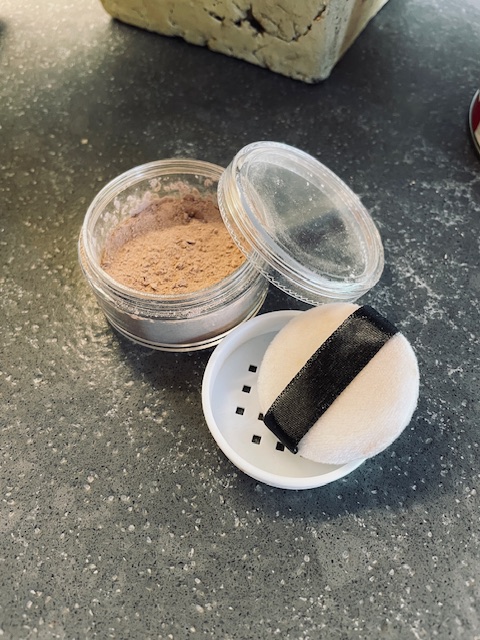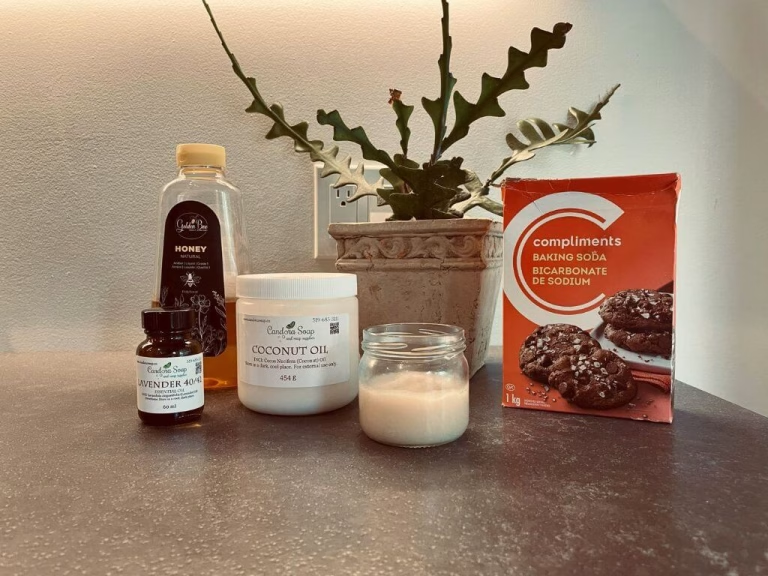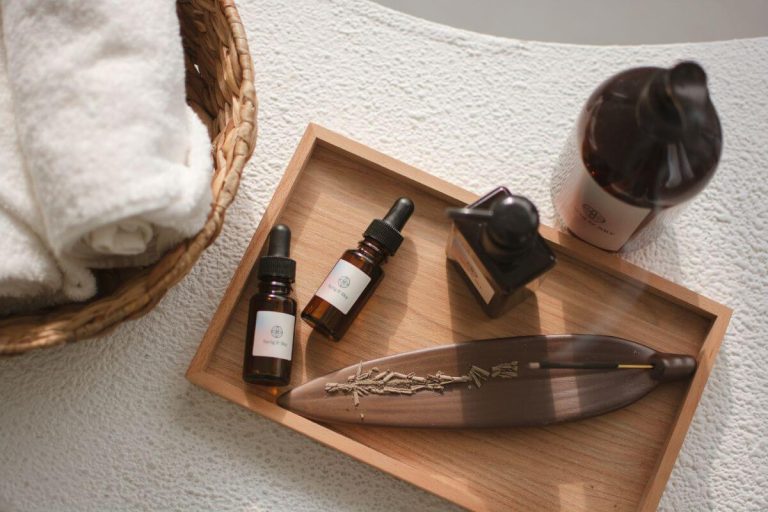How to Make Herbal Infused Oil
Unlock the power of botanicals: how to infuse carrier oils with herbs for nourishing salves, rich body butters, handcrafted soaps and so much more.
This post may contain affiliate links. Please see our disclosure policy in Terms of Use.
Have you ever been making a salve or body butter recipe that calls for an oil—like olive or jojoba—plus a handful of essential oils, and thought, ‘I wonder if I could just infuse the oil with this herb instead?’.
That was exactly my thought when I first started making my own skincare. So, I did some digging—and guess what? The answer is a big yes! Not only can you do it, but it actually works even better.
Through my personal research, I’ve discovered how amazing herb-infused carrier oils are. They can be used so many ways …. basically whenever a recipe calls for some sort of carrier oil, you can replace it with a herbal infused oil instead. Then not only do you get the health benefit of the oil itself, you also get the health benefit of whatever herb you’ve infused the oil with.
It’s a perfect combo!
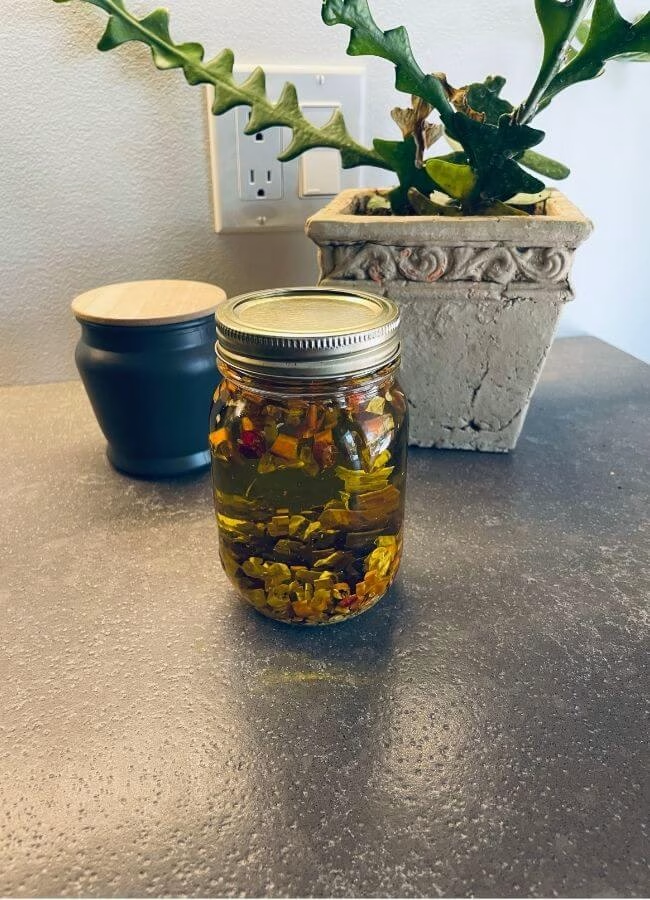
If you are feeling like you have no idea where to even start with making your own products, like I was, check out my blog Ditch the Toxins: The Benefits of Making Your Own Cleaning and Skincare Products.
I think you will find my Getting Started Guide super helpful as well! I’ve created an easy to follow cheat sheet with the only ingredients you need for getting started. It also includes the first 3 recipes I started with, and that I suggest you do too. You can replace so many commercial products in your house with just these 3 recipes. And they are perfect for beginners.
The Benefits of Herbal-Infused Oils
When you infuse carrier oils with herbs, you’re unlocking so much more than just a beautiful scent — you’re creating a nutrient-rich base that transforms any DIY recipe. Herbal-infused oils bring the best of both worlds: the moisturizing power of carrier oils like olive or jojoba, and the skin-loving properties of the herbs themselves.
These infused oils deliver vitamins, antioxidants, and soothing plant compounds that help nourish and protect the skin. Whether you’re making a healing salve, a whipped body butter, or even soap, using herb-infused carrier oils can enhance your creations in both performance and feel.
Here are a few reasons why herbal-infused oils make such a difference:
- 🌼 Deeper nourishment: Infused oils absorb the herb’s natural benefits, helping to soften, calm, and restore the skin. Essential oils can have similar benefits, however they can not be grown in your backyard, and can be quite costly.
- 🌿 Enhanced natural scent: Subtle herbal aromas add a gentle, earthy fragrance without synthetic perfumes. They truly help to mask some of that not so pleasant oil smell you may not love. Depending on the herb used, I find this is one of the best ways to add a natural, beautiful scent to my products.
- 💧 Added skin protection: Many infused oils help support healing and hydration, reducing dryness and irritation. Many plants and herbs are wonderful medicine for a whole bunch of different issues. Infusing your oil with them, adds all these additional health benefits to your oil.
- 🧴 More effective DIY products: Salves, butters, and soaps made with infused oils feel richer and more luxurious.
- 🌿Gentle and safe for kids: Unlike essential oils, herbal infused oils are safe for use on all members of the family because they are not as highly concentrated as essential oils.
- 🌼Can be used for cooking: It’s not just your skin care products that will get a boost from your DIY herbal oil infusion, the can also add a boost of flavour to your favourite recipe. For instance, I make a cayenne pepper infused olive oil that is great to add some heat to any sauce.
So next time you’re crafting your favorite natural skincare recipe, reach for an herbal-infused carrier oil — it’s an easy upgrade that makes your homemade products truly shine.
Turn Simple Oils into Herbal Magic: How to Infuse Oils for Natural Skincare Recipes
Below are two reliable ways to make herbal-infused carrier oils: a slow cold method that preserves delicate plant compounds, and a faster low-heat method when you want your oil as soon as possible. The slow cold method is the preferred method because too much heat can harm the compounds in the herbs.
I suggest using dried herbs only (if you dry your own fresh herbs, that will give you the best results) — moisture from fresh herbs encourage spoilage. That said, there are some people who use fresh herbs, so do some research and experiment if you’d like.
Before you begin — what you’ll need
- Carrier oil: olive, sweet almond, jojoba, grapeseed, sunflower or avocado. Choose based on the recipe (olive or avocado for salves; jojoba or sweet almond for face/body).
- Dried herbs: calendula, chamomile, lavender, rosemary, comfrey, plantain, rose petals, cayenne pepper, etc.
- Clean, dry glass jar with lid (amber glass is ideal but I usually just use any jar I have like a mason jar).
- Double boiler / slow cooker for hot method only.
- Cheesecloth / fine mesh strainer / funnel.
- Optional: Vitamin E oil (natural antioxidant) to extend shelf life; label and date stickers.
Ratio guideline: Fill your jar about ½–¾ full with dried herbs, then pour oil to completely cover the herbs with about 1 inch (2–3 cm) of extra oil on top. For a quick approximate volume: for 1 cup (240 ml) of oil use roughly ½ to 1 cup dried herbs depending on how densely they pack.
Cold (Slow) Infusion — best for fragrance and delicate herbs
Great when you want maximal retention of delicate aromatics and plant goodness.
- Sterilize jars: Wash and dry a clean jar and lid. Make sure everything is fully dry, there can be NO moisture.
- Add herbs: Place dried herbs loosely into the jar — don’t pack them tight. Fill to ½–¾ full.
- Pour oil to cover: Pour carrier oil over the herbs until herbs are fully submerged and there’s ~1 inch of oil above the herbs. Avoid leaving any herb exposed.
- Seal & label: Screw the lid on snugly. Label with herb name and start date (so important not to forget to label your jar, you will forget what’s in it).
- Store in a Dark Cool room: Place the jar in dark and cool room. Let it sit for a minimum of 4–6 weeks, even longer is better. Gently shake the jar once daily or every few days to redistribute plant material.
- Check & strain: After 4–6 weeks, check scent and color. When satisfied, strain through fine mesh strainer (a cheesecloth can also be used but you lose more of the oil) into a clean bowl.
- Bottle & store: Funnel the infused oil back into a clean jar. Add a few drops of Vitamin E per cup of oil if desired. Label with herb, oil, and date. Store in a cool, dark place. Shelf life: 6–12 months (often closer to 6–9 months depending on oil).
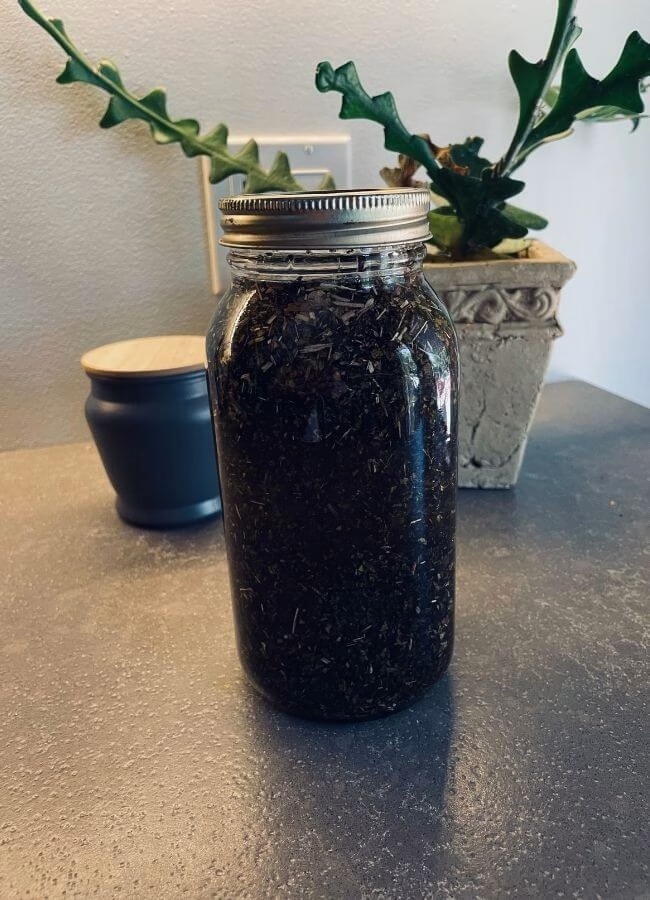
Hot (Quick) Infusion — same/next-day oil (use gentle heat)
Great for when you want infused oil quickly. Keeps temperatures low to protect beneficial compounds.
Option A — Double boiler:
- Prep: Place dried herbs in a heat-proof bowl or jar that will sit in the double boiler. Use same herb:oil ratio as above.
- Low heat: Fill the bottom of the double boiler with water and keep it at a very low simmer. Place the jar/bowl with herb + oil in the top. Maintain a steady low heat so the oil warms but does not boil. Aim for 110–130°F (43–54°C) — avoid higher temps.
- Warm for 2–4 hours: Gently warm for 2–4 hours, keeping water level and temperature consistent. Stir occasionally.
- Cool & strain: Let cool, then strain through fine mesh strainer. Bottle and label. Add Vitamin E if desired. Store in dark glass; shelf life ~6–9 months.
Option B — Slow cooker / Crockpot (this is the way I do it!):
- Combine herbs and oil in a glass jar and lightly place on lid.
- Heat low and slow: Place a towel on the bottom of the crockpot so the jar isn’t directly against it. Put jar in the crockpot, add water to the crockpot so it reaches about halfway up the jar. Set crockpot to the lowest setting (or warm).
- Infuse 12–24 hours: Keep it warm for 12–24 hours. Check occasionally to ensure it’s not too hot.
- Cool, strain, store as above.
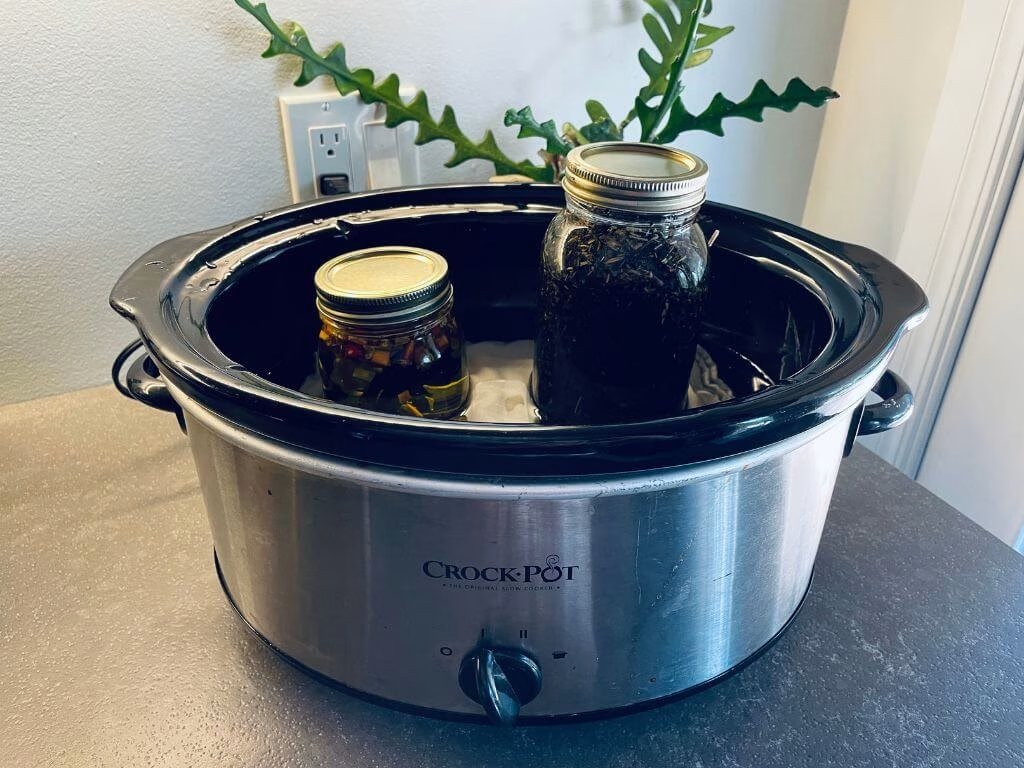
Important safety notes & troubleshooting
- Always use fully dried herbs. Fresh or damp herbs introduce water and can cause mold and spoilage.
- Do not overheat. High heat destroys delicate constituents and can make the oil smell “cooked.” It will ruin many of the beneficial properties of the herbs and carrier oil. So, keep temps low (110–130°F / 43–54°C) for the two hot methods.
- Watch shelf life. Oils with high unsaturated fatty acids (e.g., flaxseed) go rancid faster; choose stable oils for longer shelf life (my favourite’s to use are avocado and olive oil).
- Allergy caution. Always patch test new oils/herbs before full use.
- No preservatives for oils. Oils don’t need preservatives, but always keep them dry and clean — contamination shortens shelf life.
Top 3 Tips for Success
- Use dried herbs (to avoid mold).
- Label each batch with the date and ingredients.
- Experiment with small batches first to avoid waste.
If you loved this recipe, don’t forget to share it with a friend and save it to Pinterest so you’ll always have it handy. And if you want more simple, natural recipes, be sure to subscribe to my newsletter – I’ve got plenty more tips and recipes coming out on a weekly basis.
